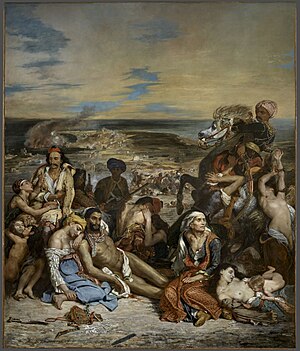สำหรับภาพวาดโดยเออแฌน เดอลาครัว ดูที่ การสังหารหมู่ที่ไคออส (ภาพวาด)
การสังหารหมู่ที่ไคออส (กรีก: Η σφαγή της Χίου, เสียงอ่านภาษากรีก: [i sfaˈʝi tis ˈçi.u]) เป็นความวิบัติของกองทัพออตโตมันที่ทำให้ประชากรชาวกรีกสี่ในห้าบนเกาะไคออสเสียชีวิต ตกเป็นทาส และหลบหนีในช่วงสงครามประกาศอิสรภาพกรีซใน ค.ศ. 1822[1][2][3] ประมาณการว่ามีผู้ถูกฆ่าหรือตกเป็นทาสในช่วงการสังหารหมู่สูงถึง 100,000 คน ส่วนที่เหลือกลายเป็นผู้ลี้ภัยสูงถึง 20,000 คน[4] ชาวกรีกจากเกาะใกล้เคียงเดินทางมาที่เกาะไคออสและส่งเสริมให้พลเมืองเข้าร่วมการก่อกบฏ เพื่อตอบสนองต่อสิ่งนี้ กองทหารออตโตมันจึงยกพลขึ้นบกบนเกาะและสังหารผู้คนหลายพันคน การสังหารหมู่ชาวคริสต์ก่อให้เกิดความโกรธแค้นระดับนานาชาติทั่วโลกตะวันตก และนำไปสู่การสนับสนุนชาวกรีกมากขึ้น
ข้อมูลเบื้องต้น การสังหารหมู่ที่ไคออส, สถานที่ ...
ปิด
เป็นเวลามากกว่า 2,000 ปีที่พ่อค้าและเจ้าของเรือจากไคออสมีชื่อเสียงในด้านการค้าและการทูตทั่วทะเลดำ ทะเลอีเจียน และทะเลเมดิเตอร์เรเนียน จักรวรรดิออตโตมันอนุญาตให้ไคออสควบคุมกิจการของตนเองได้เกือบทั้งหมด เนื่องจากการค้าในไคออสและต้นแมสติกมูลค่าสูงที่เก็บเกี่ยวได้เฉพาะในไคออสมีคุณค่าอย่างยิ่งต่อออตโตมัน
ชนชั้นนำของเกาะไม่เต็มใจที่จะเข้าร่วมกับฝ่ายกบฏกรีก ด้วยความกลัวที่จะสูญเสียความมั่นคงและความเจริญรุ่งเรือง[5] นอกจากนี้ พวกเขารู้ตัวว่าตนอยู่ใกล้กับใจกลางตุรกีในอานาโตเลียเกินไปที่จะปลอดภัย[5] ณ จุดหนึ่ง เกาะไคออสอยู่ห่างจากส่วนกลางของอานาโตเลียเพียง 6.7 กิโลเมตร (4.2 ไมล์)
เมื่อมีการรายงานเหตุการณ์นี้ในทวีปยุโรป นั่นก่อให้เกิดความโกรธแค้นขึ้น[6] และเออแฌน เดอลาครัว จิตรกรชาฝรั่งเศส วาดภาพเหตุการณ์นั้นที่มีชื่อว่า ฉากการสังหารหมู่ที่ไคออส ทอมัส บาร์เกอร์วสดภาพเฟรสโกเกี่ยวกับการสังหารหมู่บนกำแพงดอริกเฮาส์ที่บาธ[7]
หลังการสังหารหมู่ รัฐบาลปฏิวัติกรีกสามารถรวบรวมเงินจำนวนมากเพื่อพัฒนาเรือของตนและโจมตีกองเรือออตโตมัน
ในช่วงปลายพฤษภาคม กัปตันกรีกจากปซาราและไฮดราตัดสินใจเผาเรือธงออตโตมัน เรือรบแนวเส้นประจัญบานที่มีปืนใหญ่ 84 อัน Mansur al-liwa ด้วยเรือไฟ โดยปฏิบัตการในคืนวันที่ 18 มิถุนายน [ตามปฎิทินเก่า: 6 มิถุนายน] ค.ศ. 1822 และดำเนินการโดยคอนสตันตินอส คานาริส (Konstantinos Kanaris) และอันเดรียส พิพินอส (Andreas Pipinos) ลูกเรือออตโตมันประมาณสองพันคนเสียชีวิตหรือจมน้ำ ซึ่งรวมถึง พลเรือเอก นาซูฮ์ซาเด อาลี พาชาที่นำการสังหารหมู่ที่ไคออสช่วงสองเดือนก่อนด้วย[11]
นาซูฮ์ซาเด อาลี พาชา (Nasuhzade Ali Pasha) พลเรือเอกออตโตมันที่นำการสังหารหมู่ที่ไคออส
หัวกะโหลกมนุษย์ที่หลงเหลือจากการสังหารหมู่ที่เนอาโมนีแห่งไคออส
อิบราฮิม เอดเฮม (Ibrahim Edhem) จากตระกูลสกรามังกา (Skaramanga family) และบรรดาบุตร
จอร์จีโอส สตราเวลากิส (Georgios Stravelakis) ผู้รอดชีวิตจากการสังหารหมู่ตอนอายุ 5 ขวบ ถูกขายเป็นทาส
[12] ภายหลังกลายเป็น
นายกรัฐมนตรีตูนิสใน ค.ศ. 1837 ถึง 1873
[13]
Brewer 2011, p. 157: "The kapitan pasha, Kara Ali, was ordered to Chios with a powerful fleet and with orders to convey 15,000 men to Chios from Chesme, where 30,000 had now gathered. Many were volunteers, including it was said a whole infantry regiment of Muslim priests, and most were simply attracted by the riches of Chios. The British consul at Smyrna reported that 'we have got rid of all our ruffians, who have gone to take part in the plunder of Scio'. Strangford, Britain's ambassador in Constantinople, was worried about the control of such large numbers of unruly troops." Shirinian 2021, p. 175: "The Turkish response came in April 1822 with the plunder, massacre and enslavement of the Greek inhabitants of the island of Chios. Whereas there had been approximately 100,000 to 120,000 Greeks living on Chios before the massacre, there were only approximately 20,000 after – about 25,000 had been killed, 45,000 enslaved, and 10,000 to 20,000 had escaped. At the same time, the Aegean coastal town of Kydonies (Ayvalık), north of Chios, was also destroyed, with many of the inhabitants fleeing to Greece, along with the refugees from Chios." Cartledge, Y. (2020). "The Chios Massacre (1822) and early British Christian-humanitarianism". Historical Research. 93 (259): 52–72. doi:10.1093/hisres/htz004. ISSN 0950-3471. As many as 100,000 inhabitants were either killed or enslaved, while 20,000 escaped as refugees. ... The exact number of Chiots enslaved or massacred remains generally unknown, with different estimations given. Argenti stated that "before the massacre the total resident population of Chios was 120,000, after the massacre it was but 30,000." Long cited 41,000 Chiots being exported as slaves, which can be seen from the customs authority records, as well as 15,000 escapees from the island prior to the Kapudan Pasha’s arrival. The historians St Clair and Brewer relatively echoed Long’s number of slaves being brought to Anatolia, as did the Philhellene Thomas Gordon, who estimated 45,000. Brandt suggested “those slaughtered ran upward of 50,000, with an equal number enslaved." Rodogno reasoned that "Before the massacre between 100,000 and 120,000 Greeks had been living on Chios; by the end of it there were 20,000; many had perished, others fled or became slaves."The Times asked rhetorically: "Who can, without shuddering, read of the total ruin, the universal desolation of our famed and once happy isle (Scio); the destruction of all its inhabitants, nearly one hundred thousand"?
Cartledge, YJC (Feb 2020). "The Chios Massacre (1822) and early British Christian-humanitarianism". Historical Research. 93 (259): 52–72, at p.60. doi:10.1093/hisres/htz004. Morsy, Magali (1984). North Africa, 1800–1900: A Survey from the Nile Valley to the Atlantic. Longman. p. 185. ISBN 0-582-78377-1.
- Christopher A. Long – The Series of Events.
- The Massacres of Chios Described in Contemporary Diplomatic Reports, edited and with an introduction by Philip P. Argenti (London: John Lane the Bodley Head Ltd., 1932).
 "The Sisters of Scio" is a poetic response to the massacre by Felicia Hemans, first published in The Literary Souvenir annual for 1830, with an engraving by Henry Rolls of a painting by A. Phalipon.
"The Sisters of Scio" is a poetic response to the massacre by Felicia Hemans, first published in The Literary Souvenir annual for 1830, with an engraving by Henry Rolls of a painting by A. Phalipon.
